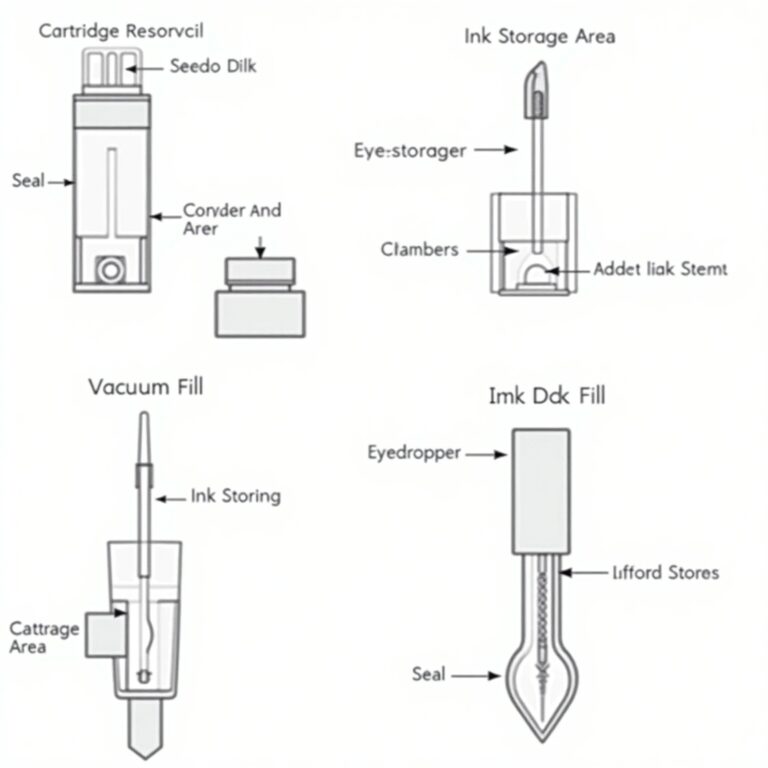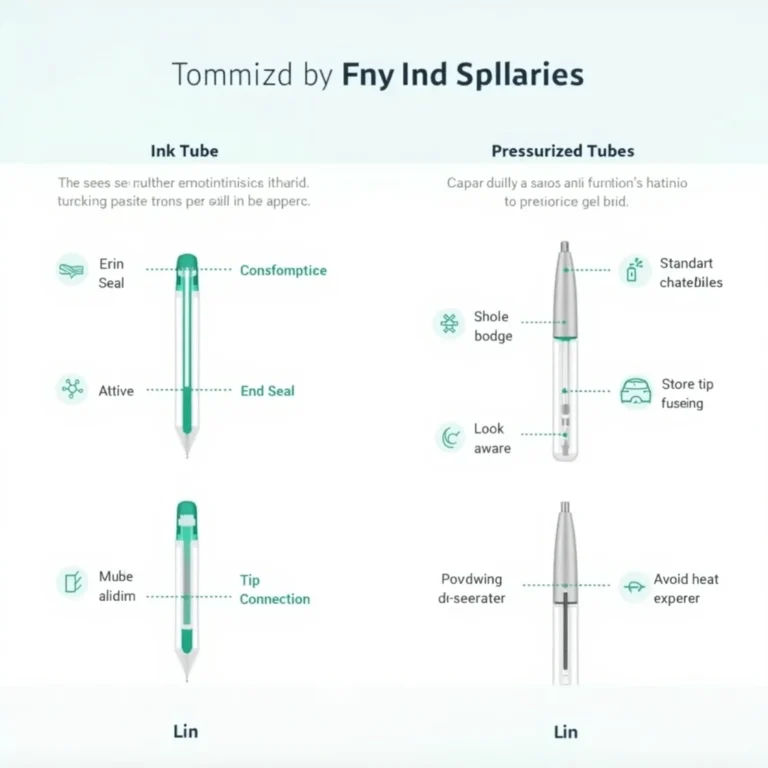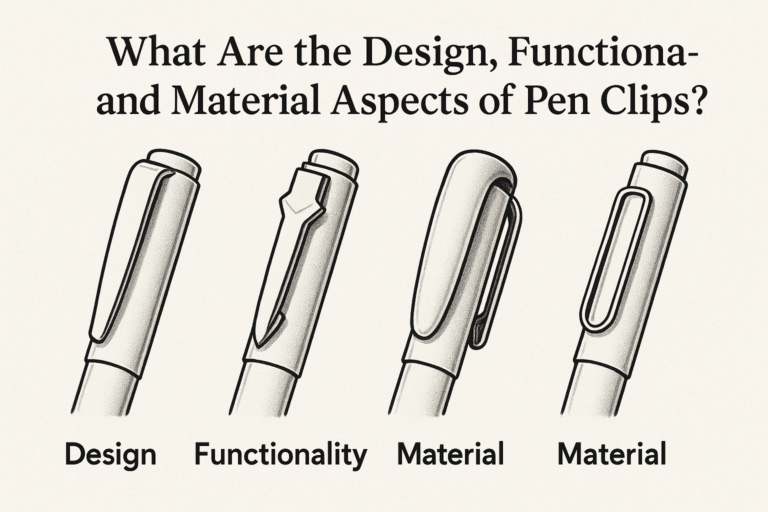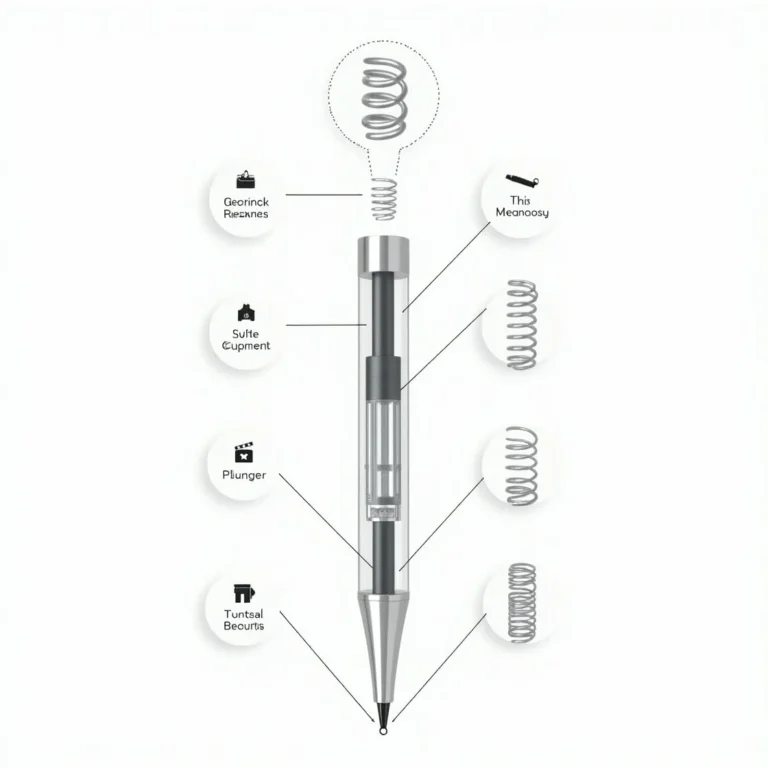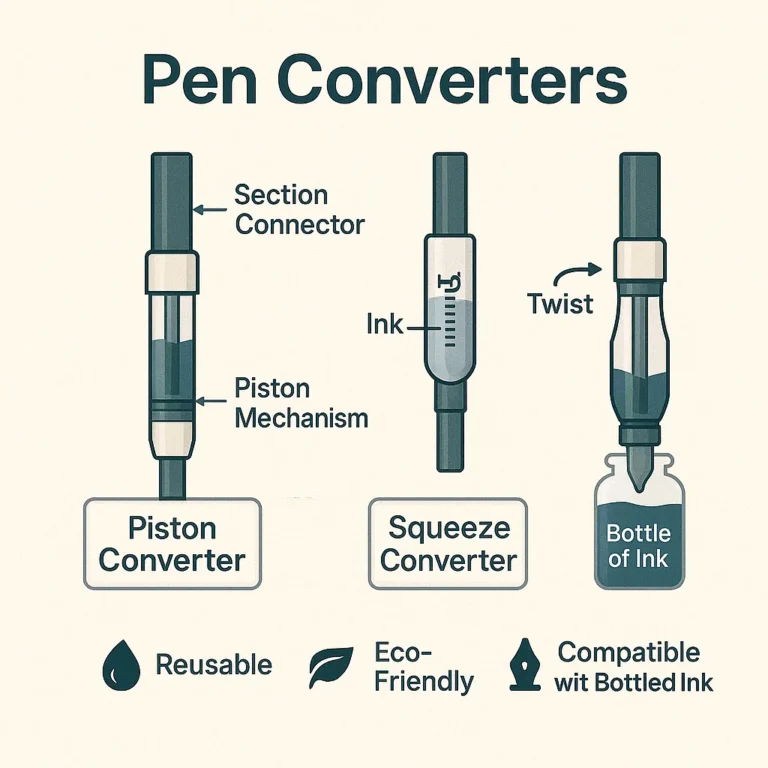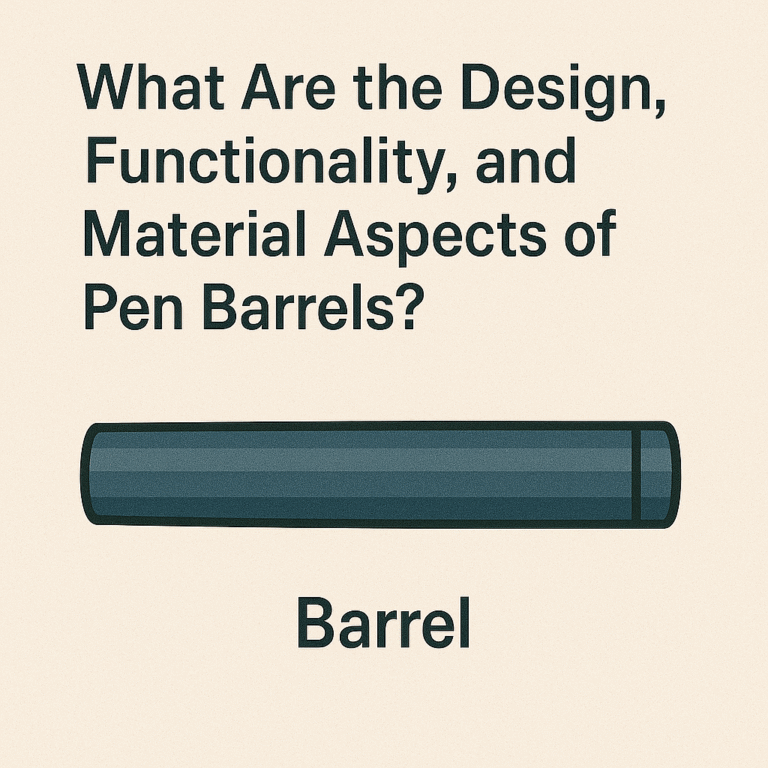“What Are the Key Parts of Pen Anatomy?
A pen might look simple, but it has many parts. Each part has a specific role, especially in how the pen is called the cam. The key parts of pen anatomy include the cap, clip, barrel, grip section, end cap, ink cartridge/refill, reservoir, feed, nib, ballpoint, tip, and other components. Each part serves a specific function that contributes to the pen’s performance, comfort, and usability.
Understanding the anatomy of a pen helps in choosing the right one for your writing needs and appreciating its design.
Key Takeaways
- Pens have parts like caps, clips, barrels, and ink cartridges. Each part has a specific function that helps the pen work properly.
- Caps prevent the ink from drying out. Barrels hold all the parts of the product together. Grips make writing more comfortable, reducing the wear on your fingers during extended use.
- Different pens use different methods to move ink. Fountain pens use feeds and nibs, while ballpoint pens use tubes with rolling balls to apply ink to paper.
- Some pens allow you to refill them using a converter to draw ink from bottles. This option lets you choose various ink colors.
- Understanding pen parts can help you select the best custom pen for your needs, improving your writing experience.

Key Parts of a Pen and Their Functions
The cap protects the writing end and prevents ink from drying, ensuring that the pen remains affordable for everyday use. Clips make it easy to attach the pen to pockets or notebooks. The barrel holds all parts of the pen together. A grip section ensures comfortable writing.
An ink cartridge or refill stores the ink inside the pen. In fountain pens, this ink moves through a feed to reach the nib, allowing you to write on paper. Ballpoint pens have an ink tube that works with a spring for clicking action.
Fountain pens can pull ink from bottles using converters. Some pens show how much ink is left through a window.
Every component plays a role in transforming your thoughts into written words smoothly.
Cap
Caps protect the writing tip and prevent ink from drying out, helping pens last longer. Some caps come with clips, allowing you to attach them to pockets or notebooks for easy transport.
Caps also enhance the pen’s appearance, contributing to a better writing experience by adding style. They are essential for daily pen usage and enjoyment.
Clip
The clip on a pen attaches to a shirt pocket or notebook, preventing the pen from getting lost. It also influences the pen’s appearance and how it feels to hold, which can be critical for best-selling models. Some clips are made durable for frequent use.
The position of the clip affects the pen’s balance and comfort during writing.
Barrel
A pen’s barrel is essential. It holds the internal parts, providing strength and stability. The barrel’s material and design affect the pen’s weight, impacting how comfortable it feels during long writing periods.
Barrels also influence a pen’s appearance. Now, moving on to the grip section.
Grip Section
The grip section on a custom pen ensures comfort while writing. It prevents your hand from tiring during long writing sessions. This part allows for better control over the pen, thanks to various designs that cater to individual writing styles.
Different pens feature unique grips to match personal preferences.
Next, the end cap plays a role in the anatomy of a pen.
End Cap
End caps stop ink from leaking out of the pen’s back. They keep ink ready for use in a removable cartridge. These parts also show the brand’s mark or design, making the pen look better. Different pens have different end caps.
A well-made end cap stops leaks and adds style to your writing tool.
Window (Ink Viewport)
An ink viewport on a pen, often found on the barrel, shows how much ink remains. This feature prevents sudden ink shortages during the use of a business product, particularly when the pen is called the cam. While not all pens include an ink viewport, it’s a useful component in many models.
It ensures you can monitor your ink level directly, making it easier to know when to refill or change the ink cartridge. This leads to uninterrupted and consistent writing sessions.
Ink Cartridge/Refill
Ink cartridges are essential for smooth writing, allowing ink to flow to the pen’s tip. They fit in both ballpoint and fountain pens, ensuring a consistent supply of ink for a smooth writing experience on any screen. For those preferring bottled ink, fountain pens can use an ink converter instead of disposable cartridges, reducing waste.
A high-quality ink cartridge prevents stops and skips during writing, crucial for frequent writers who rely on their pens to perform flawlessly.
Reservoir
The ink reservoir in fountain pens and some refillable pens stores ink for writing, preventing wear and tear on the pen. It ensures a steady flow to the nib with the help of the feed. The reservoir’s size affects how much ink the pen can carry and its lifespan before a refill is needed.
Learning about the reservoir gives insight into pen operation and design.
Feed
Ink moves from the reservoir to the nib through the feed. The feed allows ink to flow smoothly, guiding it directly to the nib for uninterrupted writing. This part is crucial in fountain pens for a flawless writing experience, ensuring words appear clearly on paper.
Spring (in retractable pens)
The spring in retractable pens is crucial. It helps the pen tip extend for writing and retract to hide. This action, powered by the spring, allows for quick use. A well-designed spring ensures the pen remains durable and functional over time.
Good springs contribute to a smoother writing experience with retractable business pens.
Ink Tube (in ballpoint pens)
An ink tube in a ballpoint pen is crucial. It holds the thick ink for smooth writing. This part sits above the ink cartridge and moves ink to the pen’s tip, ensuring steady flow without leaks.
This tube, part of what the pen is called the cam, also improves your writing quality. Without it working properly, pens would fail to put ink on paper correctly. It collaborates with the barrel and ballpoint for easy, clear writing every time you use a pen.
Plunger/Push Mechanism
Click pens work with a push mechanism. You press to extend the writing tip and press again to retract it. This feature makes writing faster and more convenient, perfect for retractable pens.
Nib (Fountain Pen)
We now turn to the nib of a fountain pen, a crucial component. The nib is the metal tip that releases ink onto paper. It varies in shape and size, affecting your writing style. Together with the feed, it ensures smooth gel ink flow during writing.
A quality nib can enhance your writing experience, making it a sought-after part of a ballpoint pen.
Nibs play a vital role in fountain pen performance. They need to align with feeds for effective ink control. Knowing what makes a nib special enhances enjoyment of using fountain pens, as each one provides a unique way to write based on its design and size.
Ballpoint (Ballpoint Pen)
A ballpoint pen uses a tiny ball at the tip to release ink from a tube inside, creating visible words on paper. The pen cap protects the tip and prevents the ink from drying out. The grip section near the bottom of a gel pen ensures comfortable writing without strain.
Inside, an ink cartridge or refill supplies more ink to the tip as needed for continuous writing flow.
Tip/Point
The tip, also known as the point, is crucial for connecting the pen to paper. Ballpoint pens use a small ball at their tips to release ink, while fountain pens have nibs that guide ink from the reservoir to the page.
The design of these tips affects writing quality and comfort. Properly crafted tips ensure smooth ink flow and enhance the writing experience across various instruments like pens and mechanical pencils.
Feed Fin (Fountain Pen)
Feed fins are crucial in a fountain pen’s feed. They hold tiny grooves that manage ink flow to the nib, ensuring smooth writing. These grooves rely on capillary action for steady ink movement from the ink reservoir in a gel pen.
Without properly functioning feed fins, you may face skipping or uneven ink distribution during writing. Understanding the role of feed fins enhances your experience with fountain pens by avoiding common issues like blotting and skipping.
Converter (Fountain Pen)
Converters have a significant role in fountain pens, offering the use of bottled ink. This choice allows a broader selection of ink colors compared to pre-filled cartridges, catering to a wide range of preferences. Unlike cartridges, converters can be refilled, enriching the user experience by enabling them to select their favored ink, making it an affordable choice.
To benefit from a converter, dip the fountain pen nib in ink and rotate the converter’s top. This motion absorbs ink into the removable storage chamber. Prepared for manuscript, the pen now expresses your color preference.
Converters extend ink choices for the customer and also decrease waste via their reusability. They add to the distinctive charm of fountain pens by enhancing operation and aesthetics for a variety of writing activities such as taking down notes or composing letters.
How These Parts Work Together
In a fountain pen, the ink converter stores ink. This ink travels through the feed to reach the nib or ballpoint at the end of a classic stick pen. The grip section makes holding the plastic pen easy and comfortable.
Retractable pens have a built-in spring that lets you push down on the plunger to show or hide the tip.
The barrel keeps all parts secure. Ink moves from the reservoir to paper through capillary action, using either a nib in fountain pens or a rolling ball in ballpoint pens, which are popular parts of a ballpoint. This design ensures clear writing every time you use it.
Explanation of the synergy between pen parts.
Every pen part plays a crucial role, especially in the best-selling models that are designed for durability. The cap prevents the ink from drying and shields the tip. The grip section ensures comfort during long writing sessions. Inside, an ink cartridge or refill feeds ink to either a fountain pen’s nib or a ballpoint pen’s ballpoint.
Fountain pens use feed channels to guide ink smoothly from the reservoir to the nib for consistent writing. Retractable pens have built-in springs that allow them to open and close with a click, removing the need for a cap and enhancing convenience.
These components come together allowing clear and easy writing. Missing even one component, like the clip that keeps your classic pen attached to your pocket or notebook, makes using and transporting your preferred writing utensil more difficult.
Thus, each part is vital for hassle-free writing every time you use it to take notes or capture ideas.
Conclusion
Knowing the parts of a pen helps you pick better ones, leading to improved writing on any screen. Each part has its own role in the engineering of the pen. This knowledge can improve how well you write and how comfortable it feels. When you understand how these parts work together, you make smarter choices.
This means you find pens that match what you need perfectly, whether for personal use or as promotional items with your logo.
Parts like the ink cartridge, ballpoint pen tip, and fountain pen nib control ink flow. The grip section makes holding the pen comfortable. Pen caps protect the nib and have a breather hole to help manage air pressure.
The pocket clip lets you attach the pen to your clothing for easy access.
The ink reservoir holds the ink in both rollerball pens and fountain pens. A thrust device in click pens moves the tip in and out. Rollerball pens use capillary action for smooth writing.
Promotional pens often feature these elements for functionality and style. Choosing a pen becomes easier with this understanding, leading to better writing experiences.
FAQs
1. What are the main parts of a pen?
The key parts of a pen include the ink cartridge, ballpoint or fountain pen nib, ink reservoir, grip section, and thrust device. Other elements like breather hole, pocket clip or capillary action also play crucial roles in functioning.
2. How does an ink flow within a pen?
Ink flows from the ink reservoir to the writing tip through an ink channel. It relies on capillary action for smooth and consistent delivery.
3. Can you explain how different types of pens work?
Ballpoint pens, which are part of a wide range of writing instruments, use oil-based ink while rollerball pens use water-based ones; both delivered via small balls at their tips. Fountain pens have a nib that allows direct contact between its internal reservoir and paper using gravity and capillary action.
4. What’s unique about promotional pens anatomy?
Promotional pens often feature additional components such as touchscreen stylus ends or mechanical pencil mechanisms along with regular parts like ball-point pen components for versatility in usage.
5. Are there any special parts in fountain pen anatomy?
Yes! Apart from common features shared with other types of writing instruments, they have unique elements such as breather holes for air circulation within their internal systems and converters to refill their liquid-ink reservoirs.
